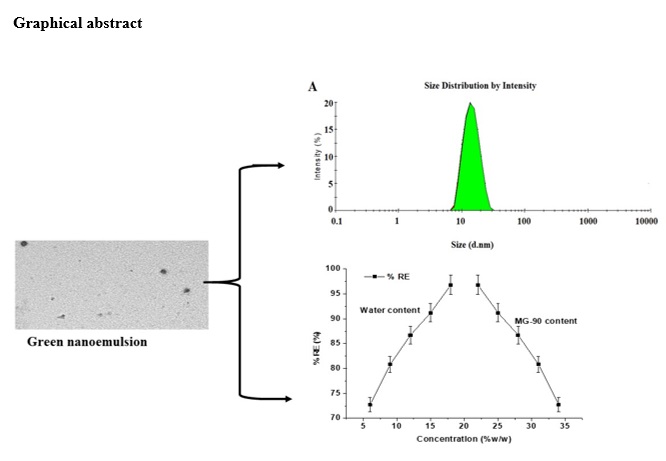Removal of azithromycin from aqueous bulk solution using water/ethanol/transcutol/capryol-90 green nanoemulsion

The present work aimed to remove azithromycin (AZM) from contaminated aqueous system using a water/ethanol/transcutol/capryol-90 green nanoemulsion. The drug is identified as potential pharmaceutical drug for detrimental effect on flora and fauna of aquatic lives and human health. Green nanoemulsions were tailored and characterized for thermodynamic stability, globular size, polydispersity index (PDI), zeta potential, viscosity, refractive index (RI), and morphological assessment using transmission electron microscopy (TEM).
Moreover, nanoemulsions were investigated for percent removal efficiency and factors affecting the %RE. The results obtained from in vitro characterization parameters suggested that the developed green nanoemulsions (ANE1-ANE5) were stable, and possessing globular size ˂ 200 nm. ANE5 exhibited the lowest value of globular size (49 nm), low PDI (0.17), minimum viscosity (~ 93 cP), and optimum zeta potential (-27.8 mV). The value of %RE depended upon the content of water and capryol-90 oil of the nanoemulsion. Furthermore, the value of %RE was found to be increased with increased content of water and decreased concentration of capryol-90 in the nanoemulsions. Similarly, % RE value was increased with decreased value of globular size and decreased viscosity of nanoemulsion.
There was no impact of contact time on %RE results. Thus, the maximum %RE value (96.8%) was obtained by ANE5 from the aqueous solution after 20 min of contact time with ANE5. Thus, this method could be a promising approach to remove AZM from a contaminated water and suitable alternative to conventional methods.
Download the full article here or read it here
Article information: Hussain A, Alshehri S, Altamimi MA, Siddique MUM. Removal of azithromycin from aqueous bulk solution using water/ethanol/transcutol/capryol-90 green nanoemulsion. Research Square; 2021. DOI:10.21203/rs.3.rs-337792/v1.
Conclusion: The study addressed to develop water/ethanol/transcutol/capryol-90 based green nanoemulsion for adsorptive removal of AZM from contaminated aqueous system at room temperature. Excipients were selected based on the drug solubility followed by nanoemulsions as dictated by phase diagrams. The globular size, PDI, viscosity, zeta potential, refractive index and % RE were influenced with the content of water and oil in the nanoemulsion. Based on the lowest value of size, PDI, highest zeta potential, maximum %RE, ANE5 was considered as the most robust and optimum green nanoemulsion to remove AZM from an aqueous solution. Thus, ANE5 may be suitable nanoemulsion for lipid adsorption based adsorptive removal of AZM from aqueous solution. The approach is simple, economic, scalable, e?cient, and ecofriendly as compared to conventional methods.
Materials: Azithromycin (AZM, ≥ 98% pure) was procured from Wockhardt (Aurangabad, India). Transcutol-HP (THP, Diethylene glycol monoethyl ether) was obtained from Gattefosse (France). Capryol-90 (MG-90) and capmul MCM C8 (CMC8, capric and caprylic acids) were gifted from ABITEC (Janesville, Germany). Ethanol, methanol, tween 80, Propylene glycol, polyethylene glycol, acetonitrile, and buffers were procured from Sigma-Aldrich, Mumbai, India. All other reagents were of analytical grade. Millipore water was used an aqueous solvent.

